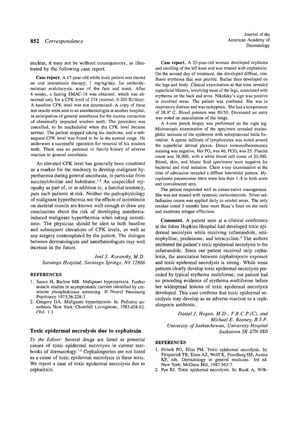Toxic Epidermal Necrolysis Due to Cephalexin
November 1987
in “
Journal of The American Academy of Dermatology
”

TLDR A woman developed a severe skin reaction called toxic epidermal necrolysis after taking the antibiotic cephalexin.
A 53-year-old woman developed toxic epidermal necrolysis (TEN) after being treated with cephalexin for erythema and swelling of the knee. On the second day of treatment, she exhibited symptoms including diffuse erythema, pruritus, bullae formation, positive Nikolsky's sign, confusion, respiratory distress, and hypotension. Biopsy and laboratory findings supported the diagnosis of TEN, and the patient had no bacterial or viral infections. She responded well to conservative treatment without systemic corticosteroids and had residual Beau's lines and telogen effluvium three months later. This case strengthens the association between cephalosporin antibiotics and TEN, as the patient had not taken any other medications that could have caused the condition.





